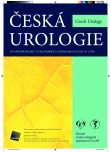Evaluation of pathology results after radical prostatectomy for prostate cancer despite „normal“ values of PSA from the viewpoint of a urologist
Authors:
Jan Schraml 1; Marek Broul 1; Martin Čegan 2; Karel Hrach 3
Authors‘ workplace:
Oddělení urologie a Centrum robotické chirurgie, Masarykova nemocnice v Ústí nad Labem, Krajská zdravotní, a. s.
1; Oddělení patologické anatomie, Masarykova nemocnice v Ústí nad Labem, Krajská zdravotní, a. s.
2; Fakulta zdravotnických studií, Univerzita J. E. Purkyně v Ústí nad Labem
3
Published in:
Ces Urol 2013; 17(2): 118-123
Category:
Original article
Overview
Aim:
Urologist’s evaluation of pathology results after radical prostaterectonomy for prostate cancer of patients with “normal” pre-operative values of PSA.
Material and method:
In the course of the 4.5 years (August 22, 2008 – November 7, 2012), we have carried out 758 robot assisted radical prostatectomies in patients with histologicaly confirmed prostate carcinomas. In this group there were 95 patients with pre-operative PSA values under 3.5 ng/ml. In retrospective analysis we documented that in this group of patients whose pre-surgical classification was cT1M0N0, according to post-surgical pathology 12.63% had locally advanced tumor (pT3a, b) and 83.15% had the tumor in both prostate lobes (pT2c). Similarly, a significant upward shift in Gleason Score (GS) was recorded.
Results:
Owerall evaluation of the risk according to pT and GS, the post-operative data showed pronounced shift into a higher risk group.
Conclusion:
This study group included mostly younger patients, seeking urology evaluation and screening for prostate cancer, or those who were identified in the early stage of illness.
Key words:
prostate cancer, radical prostatectomy, robot assisted radical prostatectomy, PSA.
Sources
1. Witmore WF, Jr. Localized prostatic cancer: management and detection issue. Lancet 1994; 343 : 1263–1267.
2. Muir CS, Nectoux J, Staszewski J. The epidemiology of prostatic cancer. Geographical distributions and time-trends. Acta Oncol 1991; 30 : 133–140.
3. Vývoj incidence a mortalita v čase online dostupný: http://www.uroweb.cz/index.php?pg=dg-nadory-prostaty-epidemiologie-ceska-republika-vyvoj-incidence-mortalita
4. Bozeman CB, Carver BS, CalditoG, et al. Prostate cancer in with an abnormal digital rectal examination and serum prostatic-specific antigen less than 4.0 ng/ml. Urology 2005; 66(4): 803–807.
5. Shröder FH, van der Maas P, Beemsterboer P, et al. Evaluation of the digital rectal examination as a screening test for prostate cancer. Rotterdm section of the European Randomized Study of Screening for Prostatae Cancer. J Natl Cancer Inst 1998; 90(23): 1817–1823.
6. Yamamoto T, Ito K, Kubota Y, et al. Diognostic significane of digital rectal examination and transrektal ultrasonograúhy in men with prostatic-specific antigen levels of 4 ng/ml or less. Urology 2001; 58(6): 994–998.
7. Broďák M, Košina J, Holub L, Navratil P, Louda M, Pacovský J. Radikální prostatektomie u pacientů s předoperačním PSA nad 20 ng/ml. Urologie pro praxi 2012; 13(4): 173–175.
8. D‘Amico AV Whittington R, Malkowicz SB, Fondurulia J, Chen MH, Tomaszewski JE, Wein A. The combination of preoperative prostate specific antigen and postoperative pathological findings to predict prostate specific antigen outcome in clinically localized prostate cancer. J Urol 1998; 160 : 2096–2101.
9. Declan GM, Kerg Mi, Crowe H, Peters JS, Costello AJ. Operative Details and Oncological and Functional Outcomes of Robotic-Assited Laparoscopic Radical Prostatectomy: 400 Cases with a minimum of 12 Month Follow-up. Eur Urol 2009; 55 : 1358–1367.
10. Chopra S, Srivastava A, Tewari A. Robotic radical prostatectomy: The new gold standard. Arab J.Urol. 2010; 10 : 23–21.
11. Trinh QD, Sammon J, Sun Maxine, Ravi P, Ghani KR, Bianchi M, Jeong W, Shariat SF, Hansen J, Schmitges J, Jeldres C, Rogers CG, Peabody JO, Montrosi F, Menon M, Karakiewicz PI. Perioperative Outcoms of Robot-Assisted Radical Prostatectomy Compared With Open Radical Prostatectomy: Results From Nationwide Inpatient Sample. Eur Urol 2012; 61 : 679–685.
12. Thompson IM, Pauler DK, Goodman PJ, et al. Prevalence of prostatae cancer among men with a prostate-specific antogen level < or = 4.0 ng per mililitre. N Engl J Med 2004; 350(22): 2239–2246.
Labels
Paediatric urologist Nephrology UrologyArticle was published in
Czech Urology

2013 Issue 2
Most read in this issue
- A case report of hydronephrosis affecting a large segment of a horseshoe kidney
- Osteonecrosis of the jaw as an adverse effect of therapy in urological cancer patients
- Lower urinary tract obstruction caused by benign prostatic hyperplasia in patients with end stage renal disease
- Evaluation of pathology results after radical prostatectomy for prostate cancer despite „normal“ values of PSA from the viewpoint of a urologist
